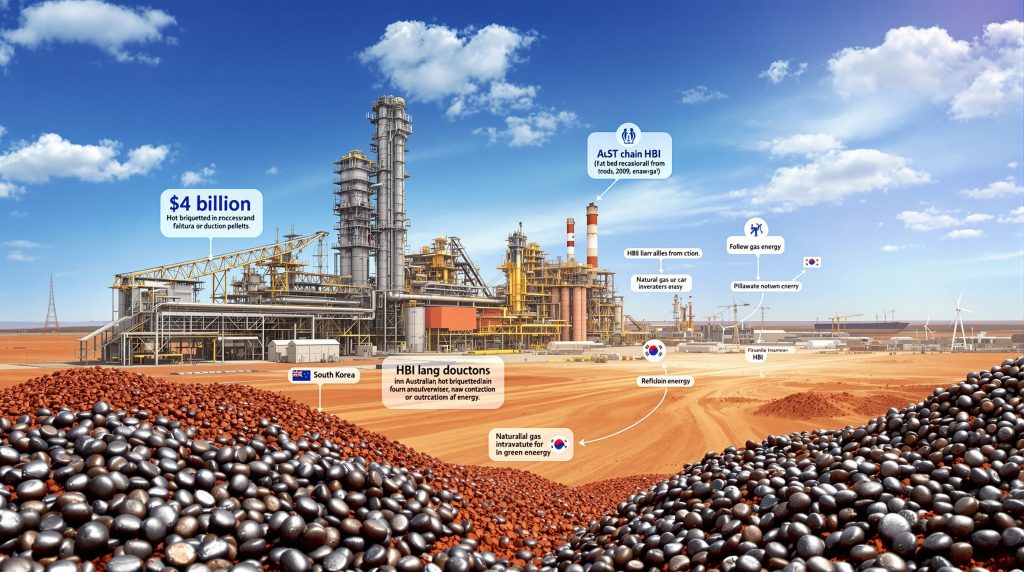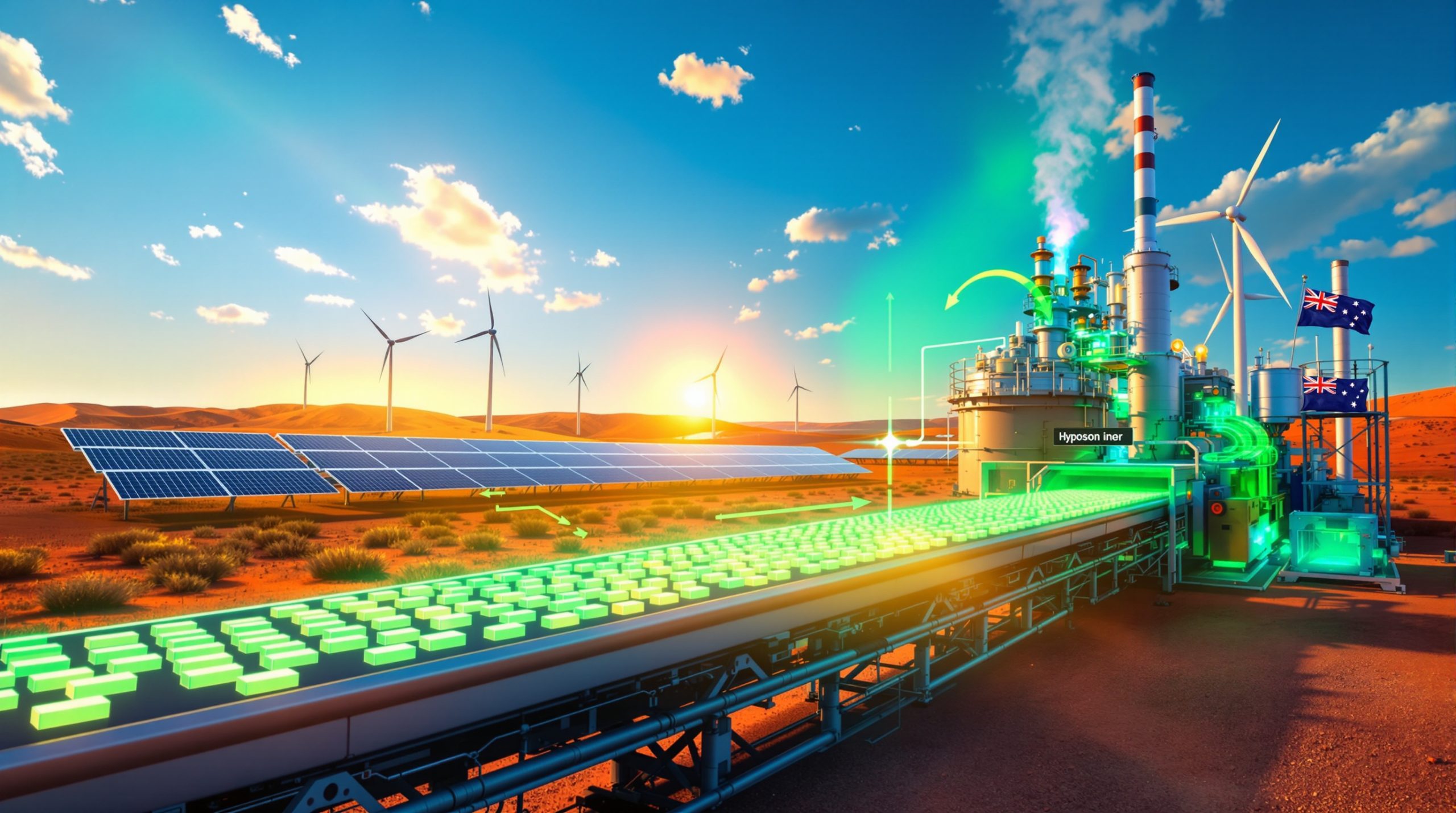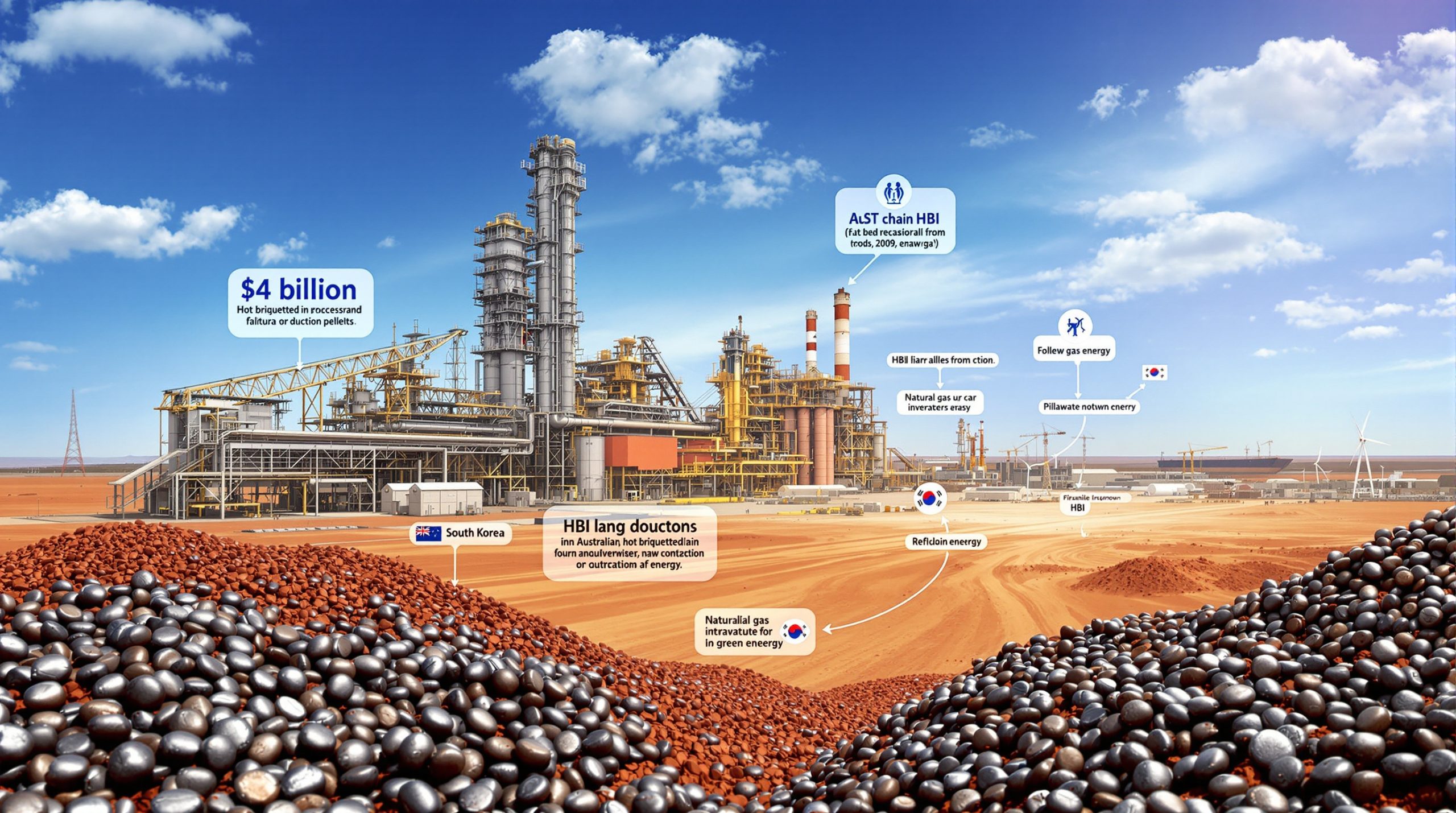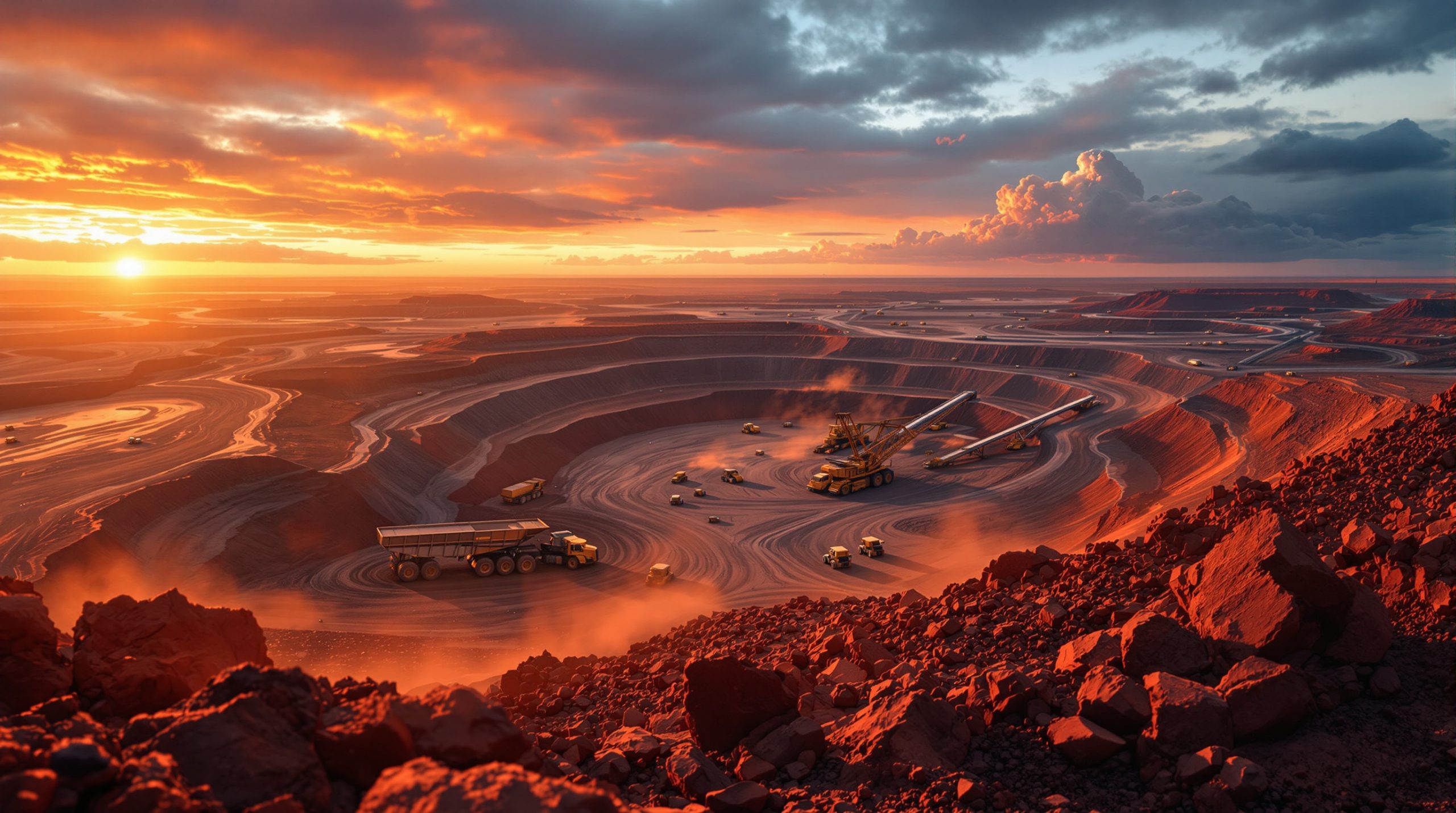Port Hedland's Hot Briquetted Iron Project: Turning Iron Into Green Gold
In a significant development for Australia's iron ore industry, a $4 billion hot briquetted iron (HBI) project in Port Hedland has received conditional environmental approval, marking a pivotal step toward diversifying the nation's resource processing capabilities and potentially doubling iron ore export revenue. Recent iron ore trends indicate this development comes at a crucial time for the industry.
What is the Port Hedland Hot Briquetted Iron Project?
The Port Hedland Hot Briquetted Iron Project represents a monumental $4 billion investment backed by South Korean steel manufacturing giant POSCO. Located in the Boodarie Strategic Industrial Area approximately 10km from Port Hedland, this ambitious project aims to transform Australia's iron ore industry by moving up the value chain.
Originally branded as the "Port Hedland Green Steel Project" before being rebranded, the facility is designed to produce 2 million tonnes of hot briquetted iron annually, creating a premium product from raw Pilbara iron ore.
Project Overview and Scale
The project's scale is impressive both in investment terms and production capacity. With $4 billion committed, it ranks among Australia's largest industrial investments outside traditional mining operations. The facility's strategic positioning near Port Hedland—a region that supplies around 40% of the world's iron ore—provides logistical advantages that few other locations globally could match.
The plant's 2 million tonne annual production capacity represents a significant processing volume that could reshape regional economics while demonstrating the viability of beneficiation opportunities in Australia's resource regions.
Strategic Importance for Australia's Iron Ore Sector
According to analysis from the Superpower Institute published in May, this project has the potential to more than double Australia's iron ore export revenue by transforming raw materials into significantly higher-value products.
This strategic shift positions Australia higher in the global steel manufacturing value chain, moving beyond simply exporting raw commodities to producing premium inputs for steel production. For a nation that has historically exported unprocessed resources, this represents a paradigm shift in resource strategy.
The project establishes a powerful precedent for future value-adding operations in the Pilbara region, potentially catalyzing additional investments in downstream processing. This diversification reduces Australia's vulnerability to market fluctuations in raw commodity prices while capturing more of the overall value chain.
How Does Hot Briquetted Iron Processing Work?
Hot briquetted iron represents a technological midpoint between raw iron ore and finished steel, offering significant advantages in terms of quality, transportability, and value.
The Direct Reduction Process Explained
The production of HBI utilizes direct reduction technology rather than traditional blast furnace methods. This process removes oxygen from iron ore without melting the metal, creating a purified iron product that's then compressed into briquette form.
Unlike conventional iron production, direct reduction allows for precise control of the chemical composition, resulting in a product with significantly higher iron content than raw ore. The briquetting process transforms this purified iron into dense, compact units that resist oxidation during transportation and storage.
The direct reduction process generally follows these key steps:
- Preparation: Raw iron ore is crushed, screened, and prepared for processing
- Reduction: The prepared ore is exposed to reducing gases (typically derived from natural gas) that remove oxygen from the iron oxide
- Compaction: The resulting reduced iron is compressed at high pressure while still hot
- Cooling: The briquettes are carefully cooled to maintain their metallurgical properties
This methodology differs substantially from traditional blast furnace techniques and represents a more targeted approach to iron production.
Value Proposition of HBI vs. Raw Iron Ore
The financial and technical advantages of HBI over raw iron ore are substantial:
- Commands significantly higher market prices than unprocessed iron ore
- Provides approximately 90-92% iron content versus 58-65% in typical iron ore exports
- Reduces energy requirements in subsequent steelmaking processes by up to 30%
- Enables more efficient and cleaner steel production downstream
- Offers greater supply chain stability for steel manufacturers with more consistent composition
- Reduces transport costs relative to value (shipping higher-value product rather than raw ore)
The premium market position of HBI creates significant value capture opportunities for Australian producers who have traditionally operated at the lower-value extraction end of the supply chain.
What Environmental Approvals Has the Project Received?
The project recently achieved a crucial milestone with conditional environmental approval from Western Australia's Environmental Protection Authority (EPA), as reported by the ABC.
EPA Western Australia's Assessment
The EPA's assessment, concluded on August 18, 2025, involved a comprehensive evaluation of the project's potential environmental impacts, with particular focus on:
- Air quality impacts from processing operations
- Greenhouse gas emissions during both construction and operational phases
- Broader environmental factors including waste management and water usage
- Cumulative impacts with other industrial developments in the Port Hedland area
In granting approval, the EPA explicitly acknowledged that while the project would create "significant" greenhouse gas emissions during its gas-powered phase, it reasoned the development would provide a net benefit to global emissions by helping decarbonize the steelmaking process over time.
The approval represents a significant milestone in the project's development timeline and indicates regulatory recognition of the potential environmental benefits of advanced materials processing despite short-term emissions concerns.
Remaining Regulatory Hurdles
Despite this important approval, several critical regulatory steps remain before construction can begin:
- Native title agreement: Consent is required from the Kariyarra traditional owners who hold native title over the area
- Land use agreement: The Kariyarra people must first reach a broader land use agreement with the Western Australian government, which remains under negotiation
- Final investment decision: POSCO has yet to make a final investment commitment pending these approvals
- Additional permits: Various construction, water usage, and operational permits will likely be required
The timeframe for completing these remaining approvals remains uncertain, with native title negotiations representing a particularly complex process that cannot be rushed.
"The environmental approval was an important step as it considered a final investment decision," a Port Hedland Iron spokesperson noted, highlighting the significance of this milestone while acknowledging the work still ahead.
How "Green" is the Hot Briquetted Iron Project?
The project's environmental credentials have become a point of debate, with significant differences between current energy plans and future aspirations.
Current Energy Plans vs. Future Ambitions
The initial operational phase will rely entirely on natural gas for energy needs, creating a substantial carbon footprint during early production years. However, POSCO has committed to a transition plan that would see the facility powered by 100% renewable energy by 2049.
This 24-year transition period from gas to renewables represents a significant timeframe during which the project will continue to generate greenhouse gas emissions. The long-term environmental benefits are therefore contingent on the successful implementation of this renewable energy transition plan.
Key transition challenges include:
- Sourcing sufficient renewable hydrogen at commercially viable prices
- Developing or securing renewable energy generation capacity
- Engineering facilities to accommodate changing energy inputs
- Managing costs during transition periods
The project's "green" credentials must therefore be evaluated within this long-term context rather than based solely on initial operations.
Expert Assessment of Green Credentials
Bill Grace, a sustainable engineering researcher from the University of Western Australia, offers a nuanced perspective on the project's environmental positioning: "It's potentially a green iron project in the long term… but it's not a green project from the outset, that's for sure."
Grace particularly questions the feasibility of sourcing sufficient renewable hydrogen, noting: "POSCO aren't proposing to produce renewable energy… so they would be buying that green energy from someone, which means someone has to have a bankable green hydrogen project to make this work."
These concerns are amplified by recent developments in the hydrogen sector. In recent months, several high-profile hydrogen projects in the Pilbara region have been abandoned by investors, raising questions about the viability of POSCO's long-term renewable energy transition plans.
The project's environmental assessment therefore requires balancing immediate emissions impacts against potential long-term benefits, all while considering the practical challenges of sustainable mining transformation in heavy industry.
What Are the Economic Benefits for Port Hedland?
The economic implications for Port Hedland extend far beyond direct project investment, potentially reshaping the region's industrial profile.
Local Economic Diversification
For decades, Port Hedland has served primarily as an export terminal for raw materials. This multi-billion-dollar hot briquetted iron project in Port Hedland represents an opportunity to diversify beyond raw material export dependency by establishing value-added processing capabilities.
Peter Carter, Mayor of Port Hedland, emphasized this transformative potential: "We've always been an iron ore port and we'll continue to be an iron ore port. But [now with] a company like POSCO coming to town and having a green [iron] mill in our town, it will attract so many other people to come and say, 'If POSCO is there, why aren't we there?' It's a big draw card for other industry to come to play."
This catalyst effect could potentially attract additional downstream processing investments, creating an industrial ecosystem rather than simply an extraction and export economy. By progressing up the value chain for local resources, Port Hedland could establish itself as a processing hub rather than merely an export terminal.
Employment and Investment Impacts
While specific employment figures haven't been publicly released, projects of this scale typically create:
- Thousands of construction jobs during the multi-year building phase
- Hundreds of permanent operational positions once production begins
- Additional indirect employment through support services and supply chain operations
Unlike traditional mining operations, processing facilities like this require a specialized workforce with advanced manufacturing skills. This necessity could drive local skills development and training programs to prepare the regional workforce for these higher-value positions.
The project represents one of the largest industrial investments in the Pilbara outside direct mining operations, potentially attracting additional supporting businesses and services to the region and further diversifying the local economy.
What Challenges Could Impact Project Success?
Despite its promising outlook, the project faces several significant challenges that could impact its long-term viability.
Hydrogen Supply Uncertainty
The project's long-term environmental and operational plans depend heavily on renewable hydrogen availability—a resource that remains unproven at commercial scale in the region.
Recent cancellations of hydrogen projects in the Pilbara raise legitimate concerns about supply certainty. BP's withdrawal from a major renewable energy hub in July 2025 highlighted the economic challenges facing large-scale green hydrogen production in the current market environment.
Since POSCO's plan relies on external suppliers developing bankable green hydrogen capacity, any shortfalls in regional hydrogen production could significantly impact the project's ability to meet its renewable energy transition timeline.
The economic viability of renewable hydrogen production remains unproven at the scale required for major industrial applications like steel production. Cost projections vary widely, creating uncertainty around the project's long-term operating expenses.
Air Quality and Environmental Considerations
The EPA noted "significant" greenhouse gas emissions during the gas-powered phase, which must be carefully managed to meet regulatory requirements. Additionally, potential air quality impacts from nitrous oxide emissions were identified in the environmental assessment.
These environmental considerations must be evaluated within the context of cumulative impacts with other industrial developments in the area. Port Hedland already hosts substantial industrial activity, and additional emissions sources require careful monitoring to maintain acceptable air quality standards.
Mayor Carter has expressed confidence in the project's environmental management, noting: "I think it will be fine. The location is about 15 kilometres out of town." While this distance mitigates direct residential exposure, comprehensive monitoring will be essential to verify actual impacts once operations commence.
The long-term environmental benefits remain dependent on the successful renewable transition outlined in POSCO's plans, creating a potential tension between short-term impacts and long-term advantages.
What's Next for the Port Hedland Iron Project?
With environmental approval secured, attention now turns to the remaining steps required before construction can begin.
Critical Path to Final Investment Decision
Several critical elements must align before POSCO can make a final investment decision:
- Native title resolution: Negotiation of a land use agreement with Kariyarra traditional owners represents a fundamental prerequisite
- Regulatory approvals: Completion of remaining permits and authorizations from various government agencies
- Energy security: Establishing viable pathways for both initial gas supply and long-term renewable transition
- Market assessment: Finalizing economic feasibility studies based on current market conditions and projections
- Partnership agreements: Securing necessary operational and supply chain partnerships
Each of these elements carries its own timeline and complexity, making precise scheduling of the final investment decision difficult to predict.
Timeline and Implementation Strategy
While no public construction timeline has been established, industry projects of this scale typically follow a phased implementation approach:
- Phase 1: Initial construction and infrastructure development (2-3 years)
- Phase 2: Commissioning and initial gas-powered operations
- Phase 3: Gradual renewable energy integration as technologies mature
- Phase 4: Complete transition to renewable power by 2049
This phased approach allows for technological evolution and adaptation over the project's lifespan while beginning production and revenue generation in the near term.
The full transition to renewable operations targeted by 2049 underscores the project's multi-decade commitment to the region, potentially spanning multiple technological generations in renewable energy and hydrogen production.
How Does This Project Fit Into Australia's Green Manufacturing Future?
The Port Hedland project represents a significant piece in Australia's evolving green manufacturing strategy, with implications that extend far beyond a single facility.
National Strategic Importance
The project aligns closely with federal government priorities for value-added manufacturing, supporting Australia's aspirations to become a green manufacturing hub rather than simply a raw material supplier.
By creating a template for future green iron and steel projects nationally, this development could demonstrate the viability of decarbonizing traditionally emissions-intensive industries while maintaining economic competitiveness.
The strategic positioning in the world's largest iron ore export region creates powerful logistical advantages that few competing projects globally can match. This geographical advantage could prove decisive in establishing Australia's leadership in green iron production.
Comparison to Other Green Iron Initiatives
Several competing technologies are being developed across Australia, employing different approaches to green iron and steel production:
- Some projects aim for immediate hydrogen-based production rather than POSCO's phased transition approach
- Other initiatives focus on different output products, such as green steel rather than briquetted iron
- Alternative approaches emphasize different technological pathways to decarbonization
The Port Hedland project distinguishes itself through scale and commercial readiness, representing one of the largest-scale commitments to date in Australia's green iron sector. According to the WA government, projects like this are essential for the state's clean energy transition.
FAQ: Port Hedland Hot Briquetted Iron Project
What makes hot briquetted iron more valuable than raw iron ore?
Hot briquetted iron undergoes processing that removes oxygen and impurities, creating a concentrated iron product with significantly higher iron content (90-92%) than raw ore (typically 58-65%). This makes it a premium input for steel manufacturing, commanding higher prices and reducing energy requirements in subsequent steelmaking processes by up to 30%.
Will this project create significant local employment?
Yes, the $4 billion project is expected to create substantial employment opportunities during both construction and operational phases. While exact numbers haven't been publicly disclosed, projects of similar scale typically generate thousands of construction jobs and hundreds of permanent operational positions, requiring workers with specialized skills in advanced manufacturing and processing technologies.
How will the project impact Port Hedland's air quality?
The EPA assessment noted potential air quality impacts from nitrous oxide emissions, particularly when considered alongside other industrial developments in the area. However, the project's location approximately 15km from residential areas is expected to minimize direct impacts on town residents. Mayor Peter Carter has expressed confidence in the environmental management plan, noting the significant distance from populated areas.
When will the project be fully powered by renewable energy?
According to POSCO's plans reviewed by the EPA, the project aims to transition to 100% renewable energy by 2049, representing a 24-year transition period from initial gas-powered operations. This timeline aligns with broader industry trends toward decarbonization but depends on the successful development of renewable hydrogen supply chains in Western Australia.
What approvals are still needed before construction can begin?
The project still requires a land use agreement with the Kariyarra traditional owners, who hold native title over the area. This agreement cannot be finalized until the Kariyarra people reach a broader land use agreement with the Western Australian government, which is still under negotiation. Additionally, various construction permits and a final investment decision from POSCO will be required before ground can be broken.
Disclaimer: This article contains information about future plans and projections that involve risk and uncertainty. The timeline for renewable energy transition, economic benefits, and environmental impacts are based on current proposals and may change as the project develops. Readers should not make investment or other decisions based solely on the information presented here.
Are You Ready to Spot the Next Major Mineral Discovery?
Discover significant ASX mineral discoveries in real-time with Discovery Alert's proprietary Discovery IQ model, transforming complex iron ore and other commodity data into actionable insights for immediate market advantage. Explore why major mineral discoveries like Port Hedland can generate substantial returns by visiting Discovery Alert's dedicated discoveries page and begin your 30-day free trial today.




